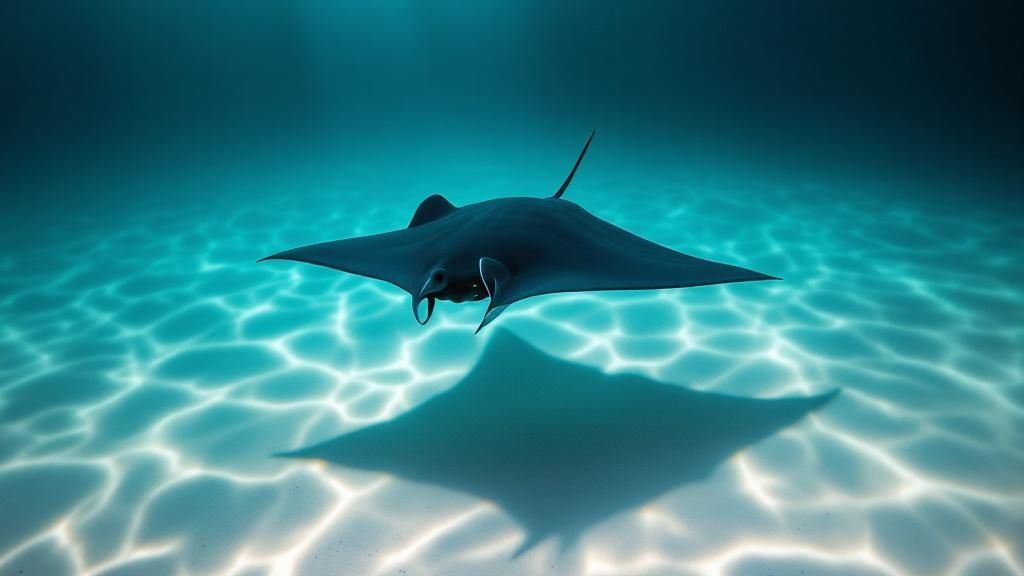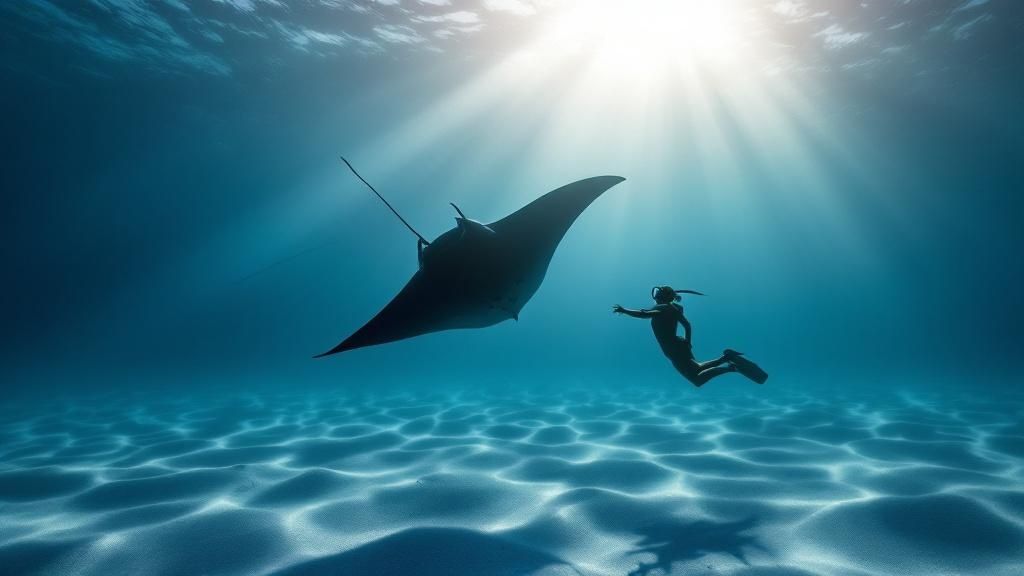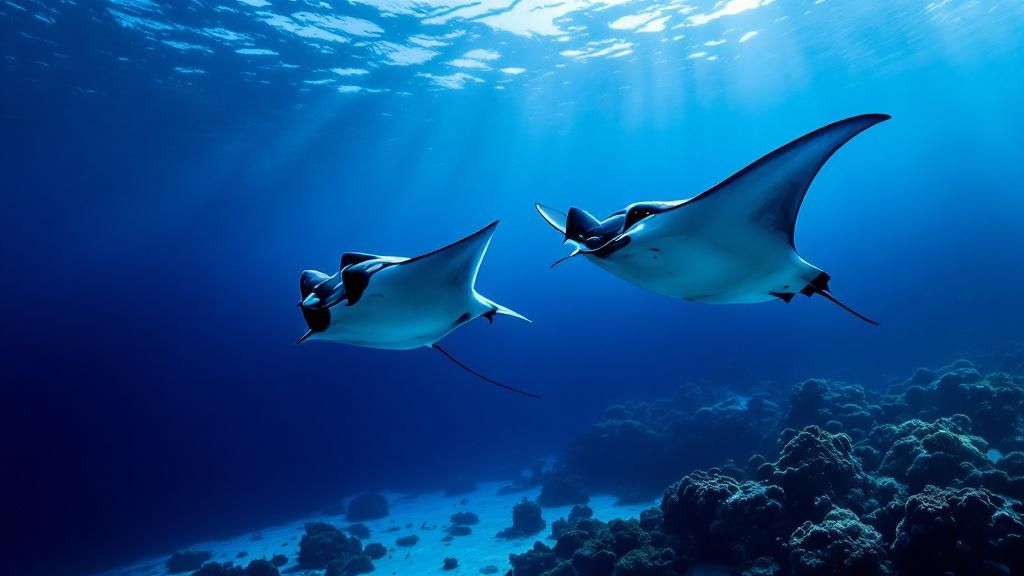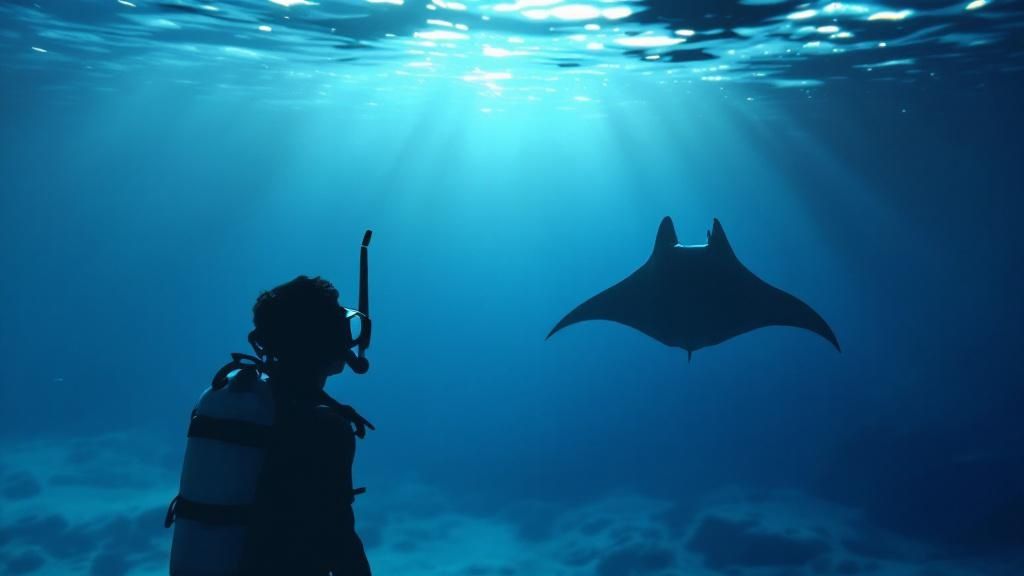Snorkeling with Manta Rays Kona: Your Ultimate Guide
- Byron
- Aug 26
- 12 min read
Picture this: you’re floating in the warm, dark Pacific waters off the Kona coast. Suddenly, a giant, graceful shadow emerges from the deep, gliding and somersaulting just inches below you. This isn't a dream—it's one of the most magical wildlife encounters on Earth, and snorkeling with manta rays in Kona is the absolute best way to experience it. This guide is your complete plan for making it happen, safely and memorably.
Your Kona Manta Ray Snorkel Adventure Awaits
We'll walk through everything, from picking the right tour operator to understanding manta ray behavior, so you can have a responsible and truly awe-inspiring time. For a consistently incredible adventure, Manta Ray Night Snorkel Hawaii is a fantastic choice. You can see what fellow snorkelers have to say about their experience right here.

Why Is This a Must-Do Hawaii Experience?
The famous manta ray night snorkel is legendary for a reason—it’s hands-down one of the most unforgettable marine encounters you can have anywhere on the planet. This isn't your typical wildlife tour where you're watching from a distance. Here, you are right in the middle of the action.
You simply float on the surface, holding onto a specially designed light board. These bright lights act like a magnet for plankton, the manta rays' favorite food. Essentially, your group creates an underwater buffet that draws these gentle giants directly to you for dinner.
Mind-Blowing Encounters: Manta rays, some with wingspans stretching over 12 feet, perform a mesmerizing underwater ballet right beneath your nose.
Unique to Kona: While you can find manta rays in other parts of the world, Kona’s unique geography and reliable plankton supply make it one of the most consistent viewing spots globally.
Accessible for Everyone: You don't need to be a scuba diver or even a super strong swimmer. The flotation boards provide all the stability you need to just relax and take in the show.
For many people, this experience goes beyond just a cool activity; it becomes a profound connection with nature. Witnessing these majestic creatures feed so gracefully is a humbling moment you won’t soon forget.
The feeling of watching a massive fish the shape of a stealth bomber swim into view is impossible to describe. It's like finding a winning lottery ticket—a truly awesome experience.
Choosing Your Tour with Confidence
Because this is such a popular adventure, picking the right company is key to having a great time. If you're looking for an exceptional alternative for either a Manta Ray night snorkel or even a Captain Cook snorkeling tour, we highly recommend checking out Kona Snorkel Trips. They run amazing trips that cater to all kinds of interests along the Kona coast.
Making the right choice isn't just about your safety and fun; it's also about protecting the mantas. A reputable guide will always give you a thorough briefing on proper etiquette, stressing the "passive observation" rule—no touching, no chasing, and no diving down toward them. Let the mantas come to you.
Choosing the Best Manta Ray Snorkel Tour in Kona
This is the most important decision you'll make for your entire trip. Seriously. Picking the right tour operator for your Kona manta ray snorkel adventure will absolutely make or break your experience. It’s not just about getting on a boat; it's about your safety, your enjoyment, and respecting the incredible creatures you’re there to see.

This isn't some niche, off-the-beaten-path activity. It’s a global phenomenon. Every year, something like 80,000 people head out on these tours. That’s a testament to how reliable it is—operators see mantas on about 85-90% of their trips. The odds are definitely in your favor.
With that kind of popularity comes a ton of options. A quick search will show you dozens of companies, and it can be hard to tell them apart. But they are not all the same. If you're looking for an operator with a stellar reputation, I always recommend checking out Kona Snorkel Trips. They consistently get it right.
What to Look For in a Great Tour Operator
When you're comparing companies, a few key things really separate the good from the truly exceptional.
First, look at the group size. Smaller is almost always better. A boat with fewer people means less chaos in the water, more personal attention from the guides, and a much better chance of getting a front-row seat for the show.
Next, find out about their guides. Are they just boat captains, or are they passionate marine naturalists? A great guide doesn't just point out the mantas; they give you a fascinating briefing on their biology and behavior. They turn a cool sightseeing trip into a genuine learning experience. And, of course, they’re the ones keeping you safe out there.
Think of it this way: a smaller, well-run tour is like having a front-row seat at a breathtaking ballet. A crowded, rushed tour feels more like you're stuck in the nosebleeds.
Understanding the Snorkel Sites
Most tours head to one of two main spots. The captain will usually pick the location based on where the mantas have been most active and what the ocean conditions are like that night.
Here’s a quick rundown of the two go-to sites:
Manta Village (Keauhou Bay): This is the classic, world-famous spot. It’s fairly shallow (10-20 feet) with a sandy bottom, which creates a perfect natural amphitheater for watching the mantas feed on the plankton attracted by the lights.
Manta Heaven (near the airport): This site, a bit further north, often has incredible water clarity. Sometimes you'll see even larger groups of mantas here. The seafloor is more of a volcanic rock landscape.
Honestly, both spots are fantastic and offer a very high chance of an unforgettable encounter. If you want to get into the nitty-gritty of each location, our https://www.mantaraynightsnorkelhawaii.com/post/manta-ray-snorkel-kona-your-complete-adventure-guide breaks it all down for you.
Ultimately, taking a few extra minutes to choose your operator carefully is the best thing you can do to ensure your night with the mantas is safe, respectful, and absolutely mind-blowing.
Getting Ready for Your Kona Manta Ray Snorkel
A little bit of prep work can be the difference between a good night and a truly mind-blowing one when you're snorkeling with manta rays in Kona. Knowing what to bring and what to expect means you can just relax and enjoy the show.

Most trips follow a similar rhythm. You'll check in at the harbor, then enjoy a beautiful boat ride out to the site as the sun goes down. Once you're there, the crew will run through a safety briefing and explain how to interact with the mantas respectfully. After that, it's time to hit the water.
What to Pack for the Trip
Your tour operator will have all the big stuff covered, but a few personal items will make your experience much more comfortable. It's all about staying cozy, both in the water and out.
Here’s a short list of must-haves:
Swimsuit: The easiest thing to do is wear it under your clothes when you arrive. You’ll be ready to go in no time.
Towel & Dry Clothes: Don't underestimate how chilly that boat ride back can feel after you've been in the ocean. A warm towel and something dry to change into are non-negotiable.
Underwater Camera: If you have a GoPro or a similar waterproof camera, this is its moment to shine. The photo ops are absolutely unreal.
Seasickness Medication: Prone to motion sickness? Take your preferred remedy before you even get on the boat. It works best when it's already in your system.
Any good tour provides wetsuits, and you'll be glad they do. The water can start to feel pretty cool after floating for 30-45 minutes. Plus, the wetsuit adds a bit of extra buoyancy, which is great for just relaxing on the surface.
How the Light Board Works
The whole Kona manta ray snorkel experience is built around a really clever piece of equipment: the light board. Forget swimming around—you'll be holding onto a big, floating board with powerful lights pointing straight down.
There are two brilliant reasons for this. First, it keeps everyone in the group together and gives you something stable to hold onto, so you can float effortlessly. But more importantly, those lights attract clouds of plankton, which is the manta rays' favorite food.
You're essentially floating on top of a dinner table that draws the mantas right in. You get a front-row seat to watch them feed without having to move an inch. It's a system perfected over years of watching these gentle giants.
Operators have become experts at predicting manta behavior, making your chances of a great encounter incredibly high. Want to pick the perfect tour? Check out our ultimate guide to Hawaii's top manta tours to help you decide.
Snorkeling Safely with Gentle Giants
Alright, let’s talk about the most important part of your manta ray adventure: keeping yourself—and these incredible animals—safe. This whole experience hinges on one core principle: passive observation. You're a quiet guest in their underwater dining room, and the golden rule is simple: look, don't touch.

It’s incredibly tempting to reach out as a manta ray glides inches from your face, but you absolutely must resist. Manta rays have a protective mucus layer on their skin, which is their primary defense against harmful bacteria. Touching them strips this layer away and can leave them vulnerable to serious infections.
By simply floating on the surface and enjoying the show, you're doing your part to ensure the mantas feel safe. This respect is what keeps them coming back to these feeding sites year after year, allowing this magical encounter to continue.
Guidelines for a Respectful Encounter
A few straightforward guidelines make all the difference for a safe and memorable trip. Before you even get on the boat, it’s a great idea to brush up on essential boating safety tips, as this sets the stage for any responsible marine adventure.
Once you’re in the water, your guide is your best friend. They live and breathe this stuff. Listen to them!
Here’s what they’ll tell you:
Stay at the Surface: Your job is to hang onto the light board and float. No diving down. This can spook the mantas and disrupt their natural feeding behavior.
Lights Pointing Down: Aim your light directly below you. This attracts the plankton, creating a glowing "campfire" on the seafloor that draws the mantas in for their meal.
Trust Your Guide: These folks are the experts. They understand manta behavior and can read the ocean's mood. Following their instructions is non-negotiable.
Manta Ray Snorkel Interaction Dos and Don'ts
To make it even clearer, here’s a quick guide on how to be the best possible guest in the mantas' world. Following these simple rules ensures a positive experience for everyone—and every manta.
Action | Do | Don't |
|---|---|---|
Positioning | Stay on the surface and hold onto the light board. | Dive down or swim underneath the mantas. |
Interaction | Observe passively and let the mantas approach you. | Reach out to touch, chase, or ride a manta ray. |
Movement | Remain calm and minimize splashing or kicking. | Make sudden movements or create a lot of commotion. |
Lighting | Keep your lights pointed down to attract plankton. | Shine your lights directly into the mantas' eyes. |
Guidance | Listen to and follow all instructions from your guide. | Ignore the crew's directions or safety briefings. |
At the end of the day, it's all about respect. By being a courteous observer, you contribute to the long-term health of Kona's manta ray population.
Staying Calm and Present in the Water
Hopping into a dark ocean at night can feel a bit unnerving at first—that's completely normal! But once you settle in, you’ll find it's an incredibly peaceful experience. The key is to relax and trust your gear.
Your wetsuit will keep you warm and buoyant, and the flotation board provides fantastic stability. Just focus on taking slow, even breaths through your snorkel. This not only keeps you calm but also helps you conserve energy. The less you thrash around, the more comfortable the mantas will be. When you’re relaxed, you can truly soak in the mind-blowing spectacle happening right below you.
Getting to Know Kona's Manta Rays
So, what’s the big deal about Kona? Why is this one small stretch of coastline the world’s most famous spot for swimming with manta rays? It’s not just a lucky accident. It’s a fascinating mix of biology and a little bit of human ingenuity that makes the magic happen every single night.
When you understand why these gentle giants show up, the whole experience shifts. It goes from just a cool snorkeling trip to a genuine connection with one of the most incredible creatures in the sea.
The stars of the show are the Pacific reef manta rays (Mobula alfredi). These are the second-largest species of manta in the world, and the ones here in Kona can have breathtaking wingspans of over 12 feet. And don't worry—they're completely harmless. Unlike their stingray cousins, they have no teeth, barbs, or stingers.
The Science Behind the Spectacle
The whole nightly spectacle boils down to a very simple food chain. It all starts with plankton.
Tour boats shine powerful lights into the water, which attract huge clouds of zooplankton—microscopic critters that happen to be a manta ray’s favorite meal. It's like setting up an all-you-can-eat buffet in the middle of the ocean. Over the years, the mantas figured out that these bright lights mean a free, easy dinner.
This creates a "campfire" effect right on the seafloor, and you get a front-row seat, floating right on the surface. You'll watch as the mantas glide, loop, and barrel roll through the beams of light, their giant mouths wide open to filter out the plankton. It’s an amazing, symbiotic relationship that brings the action right to you.
Fun fact: Every single manta ray has a unique pattern of spots on its belly, just like a human fingerprint. This is how local researchers and guides can tell them apart. They give them names and track them for years. You might get to meet a local celebrity like "Big Bertha" or "Lefty"!
Kona's Prime Manta Ray Real Estate
This underwater ballet unfolds at two main locations along the Kona coast, both famous for being incredibly reliable spots. The area’s unique volcanic geography has created sheltered bays that are perfect for these nightly feeding frenzies.
Here’s where you’ll likely go:
Manta Village (Garden Eel Cove): This is the original, classic spot just south of Kailua-Kona. It's relatively shallow with a sandy bottom, creating a natural amphitheater for the show.
Manta Heaven: Located a bit further north near the airport, this site is known for its crystal-clear water and sometimes draws even bigger groups of mantas.
Since researchers started keeping track, they've identified and cataloged over 290 individual manta rays along this coastline. That’s an unbelievable number for such a small area, and it really shows you how special this population is.
Knowing this stuff adds a whole new layer to the experience. You're not just a tourist watching animals; you're stepping into a unique ecological event that happens nowhere else on Earth. To get started planning your own trip, be sure to check out our complete night adventure guide for all the details.
Your Manta Ray Snorkel Questions Answered
Heading out into the dark ocean to float alongside giant sea creatures is an amazing thought, but it’s totally normal to have a few questions first. Let's face it, it's not something you do every day! Getting some honest answers will help you feel prepared and genuinely excited for the adventure.
We've heard just about every question in the book, from safety concerns to the best time of year to go. Our goal is to clear things up so you can stop worrying and start looking forward to one of the most incredible experiences of your life. Let’s get into it.
Do I Need to Be a Strong Swimmer?
Not at all. In fact, you barely need to swim. The whole setup is designed to be incredibly safe and easy, even for people who aren't super comfortable in the water.
You'll be holding onto a large, custom-made flotation board that’s super stable. It has handles all around and bright lights pointing down to attract the plankton (and the mantas!). Your job is simply to hold on, float, and watch the show below. The provided wetsuit also gives you extra buoyancy, so you'll feel very secure. As long as you're okay with putting your face in the water while wearing a mask, you're good to go.
When’s the Best Time of Year to Go?
Here’s the great news: any time is a good time! The Kona manta ray population hangs around all year long, so you don't have to plan your entire Hawaiian vacation around them. Local crews report successful sightings on 85-90% of their trips, regardless of the season.
That being said, if you have a choice, the months between April and October generally offer the calmest ocean conditions and slightly warmer water. But honestly, a winter trip can be just as magical. Don't let the calendar hold you back.
Is Seeing Manta Rays Guaranteed?
This is a big one. It's important to remember that these are wild animals in their natural habitat, so a sighting can never be 100% guaranteed. Nature does what it wants, and that's part of the magic.
However, the top tour operators know this and have your back with a "manta guarantee." It usually works like this: if your group doesn't see any mantas, you can come back for another trip on a different night, free of charge (as long as there’s space). This gives you peace of mind and shows the company is committed to giving you the best shot.
When you're ready to book, consider a team with a stellar reputation like Kona Snorkel Trips. Just be sure to double-check their specific sighting policy before you confirm.
Ready to get this incredible experience on your calendar? It's easy to see what dates are open.
Comments